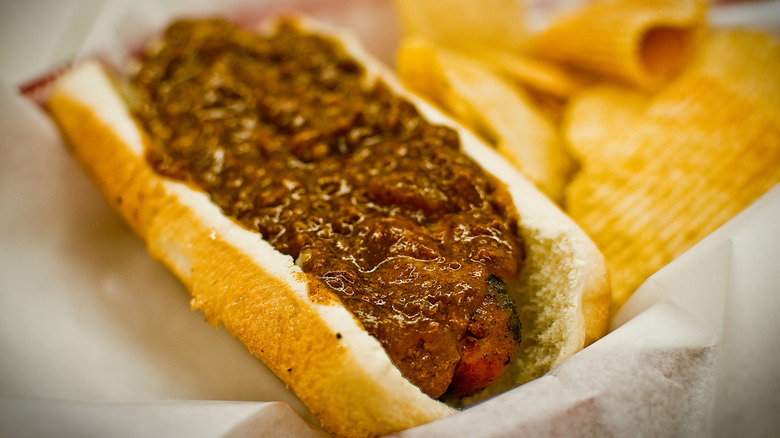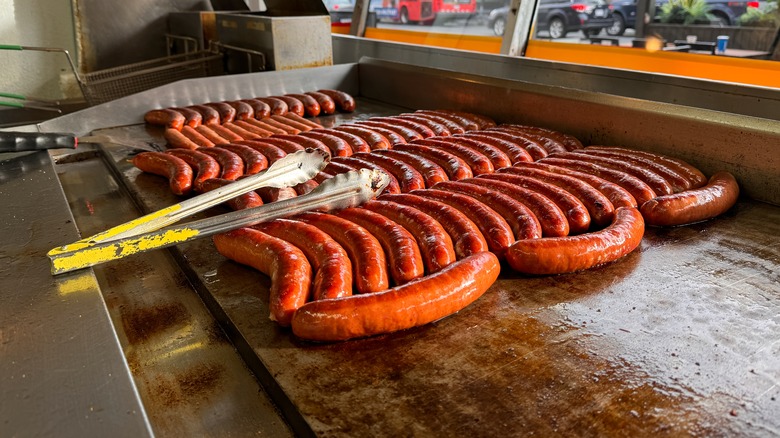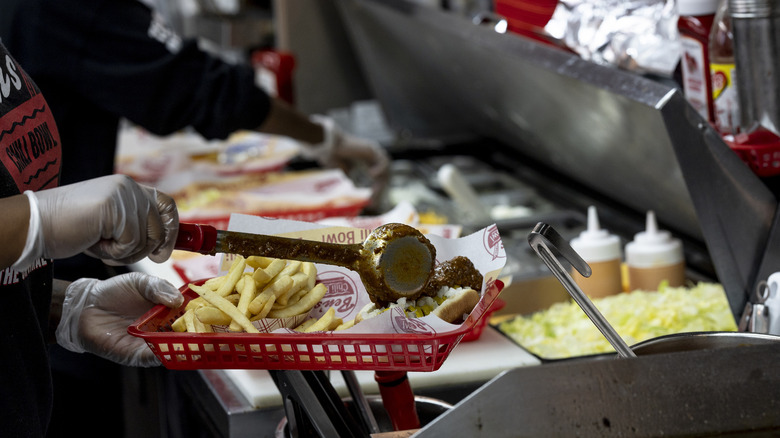Why Are Washington DC Hot Dogs Called 'Half-Smoke'?
Like barbecue, pizza, and a host of other dishes, the hot dog is a seemingly simple food with deep and diverse regional significance. As the home of the U.S. hot dog, New York serves a timeless classic: a white bun, an all-beef hot dog, steamed onions, and mustard. Chicago, on the other hand, prefers a more eclectically adorned hot dog, swapping the basic bun for a sturdier one coated in poppy seeds and topping it with — hold on to your hats — pickle spears, slices of tomato, spicy sport peppers, raw onion, and yellow mustard.
Move around the country, and you'll find more unique regional hot dog styles than you might imagine. In Washington D.C., the half-smoke hot dog reigns supreme. First served in the 1950s at Weenie Beenie's in Arlington, it's been a staple in the D.C. area ever since. If you're wondering what the name half-smoke entails, you're in good company — even the hot dog's most enthusiastic fans aren't quite sure. The name might come from the sausage's half-beef, half-pork meat blend, or the way these particular sausages are lightly smoked. Or it could be from something else altogether — the mystery is part of the fun.
The lore is part of the tradition
It may seem surprising that a dish so ingrained in D.C. culture remains such a confounding mystery, but the lore of the half-smoke is part of the tradition — everyone has their own theory. Some claim the name is due to the meat having half as much seasoning as a Polish sausage. Others guess that it refers to the sausage traditionally being cut down the middle before being placed in the bun and covered with toppings.
It turns out both are true — the defining qualities of a half-smoke are its spicy, smoky flavor, snappy exterior, and comparatively large circumference. The spice comes from incorporating red pepper flakes or another chili pepper into the meat mixture, and the size and snap are thanks to the natural hog intestine casing used to hold the sausage together. The sausage is lightly smoked and then grilled, sliced down the middle, and topped with spicy chili sauce, mustard, and onions. But are these facts enough to warrant name credit?
If anyone could be deemed a credible source in this debate, it would be Alvin Manger, the fourth-generation member of Mangers Packing Corporation, the sole sausage supplier for the half-smoke institution Ben's Chili Bowl. Manger told American University Radio that his best guess is that the combination of words in the name suggests that the sausage "is a less smoked product, producing a different flavor." But even he is quick to assert that no one knows for sure.
Variations on the classic
At some point, you have to surrender to the "what's in a name?" argument when it comes to the half-smoke. The dish is a D.C. establishment, no matter how you spin it. And even within the category, there has always been great variation.
In the decades since the half-smoke first made its mysterious name for itself, local chefs have taken greater liberties with the format, allowing their imaginations to stretch beyond the parameters of the classic they grew up with. DCity Smokehouse leans into the smoky component of the half-smoke by incorporating classic barbecue elements, while Meat & Foods invites you to build your own masterpiece, choosing from several signature chili options and a plethora of fresh, grilled, and fermented hot dog toppings with main character energy to create a half-smoke that's uniquely yours. The specific ingredients may change, but the tradition and legacy of the half-smoke remain quintessential to D.C.



